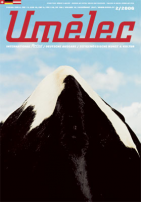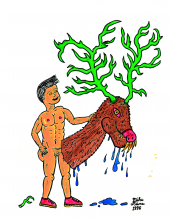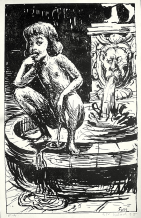| Umělec magazine 2006/2 >> Mozart and Saliera | List of all editions. | ||||||||||||
|
|||||||||||||
Mozart and SalieraUmělec magazine 2006/201.02.2006 Konstantin Akinsha | commentary | en cs |
|||||||||||||
|
When I arrived in Vienna at the end of January the city was maniacally obsessed with three topics: Mozart, the anniversary of whose birth was turned into an unbearable avalanche of visual and audio kitsch, Klimt, whose paintings including the Golden Adele after years of international litigation had to be stripped off the walls of the Belvedere Gallery and returned to the rightful owners, and, of course, the Saliera, the salt shaker by Benvenuto Cellini, stolen in a bizarre fashion from the Kunsthistorisches Museum and then recovered in a no less peculiar way.
On the first night I discovered an item in the neighborhood grocery store—one that exceeded my most pessimistic expectations. I have to confess that it looked pretty appetizing. It was just ham, a rose piece of ham with a thin layer of tender white fat delicately framing it. The ham was neatly packed in plastic film and had a label with the words, “Mozart Schinken Papagena.” The absence of quotation marks in the name of the product made unclear whose ham was lying in front of me in the glass coffin of the refrigerated meat display – Mozart’s, or Papagena’s. On the shelves standing nearby, rows of wine bottles adorned with portraits of the great composer were lined up for the anniversary parade. Everything was ready for the Mozart Eucharist, as if the poor author of The Magic Flute announced before his descent to the unmarked mass grave “Drink my blood, eat my (or my Papagena’s) flesh.” On the background of this invitation to cannibalism, marked by overtones of necro - Christianity, the old good Mozart Kugel chocolates looked like a symbol of modesty and manifestation of refined taste. Of course, I thought, “kitsch” is an Austrian word. But is “kitsch” possible today? If poetry was impossible after Auschwitz, why may kitsch be possible after Jeff Koons? Was “kitsch” itself a blueprint of the mood of aesthetic operation of our society deprived forever of “high” and “low” and doomed to use the new meta-language of emasculated linguistic clichés and “effaced images” (I mean images removed from their context, abused by constant reproduction, through which they acquired a new quality of faux symbols. The power of such symbols is measured only by the intensity of their reiteration, as the powers of the Buddhist prayer increased by rotation of the prayer wheel.) In his rehash of Russian Constructivist theory, Walter Benjamin, obsessed with the “progressive” tool of mechanical reproduction, made a serious mistake, stating, “The mass is a matrix from which all traditional behavior toward works of art issues today in a new form. Quantity has been transmuted into quality. The greatly increased mass of participants has produced a change in the mode of participation.” By now we know that quantity and especially overproduction are not necessarily transmitting into quality. But if the optimistic period of trust in the means of the liberating technology is gone, the history of mechanical reproduction has remained unwritten. It’s a shame, because the investigation of the ways in which art works have been reproduced since the invention of photography could become a valuable tool for the understanding of interpretation of art both during the last and in the beginning of this century. The farewell to the five Klimt canvases, once confiscated by the Nazis and then “appropriated” by the Austrian state, turned into a true feast of mechanical reproduction. Entering the Austrian Belvedere Gallery, a visitor saw five easels with reproductions of the Klimt paintings destined to leave to California soon, but still exhibited in the museum. The message of such display was not clear. On one hand the paintings looked like the portraits of the deceased exhibited during a funeral, on the other hand the display probably had to remind one that the various reproductions of the treasures to be lost soon are still available in the museum shop. In the halls of the gallery vigilant guards were hunting Japanese tourists trying to use their cameras despite the numerous signs reminding that photography is prohibited. The sanctity of aura was well protected. In contrast to the solemn virginity of the museum halls recalling the Garden of Eden before the fall of the mechanical reproduction, the museum shop looked like a morgue in a war zone. Klimts dissected in all possible ways and reproduced on all possible materials and objects were filling it. The very notion of so-called “fragment” which became a customary way to reproduce art works during the late 1960s - the early 1970s was an anachronism already during its heyday - the process of the fragmentation of consciousness/image was simply too slow to reach art works earlier (of course the first efforts of such dissection could be associated with the heroic epoch of avant-garde from Dada to Russian photomontage, but the mass-produced fragmentation of the artistic image became the trademark of the art publishing of the 70s.) The cinematic system of vision with unavoidable close-ups (known in Russian avant-garde film theory as “American stills”) was simply applied to the production of coffee-table art books composed of color reproductions of enlarged eyes, ears, hands and feet. However in contrast to cinema the poor dismembered images didn’t even have such uneven connection to each other as the montage sequence. Soon the alienated fragments left the book pages to continue their lives on pillows, mugs, vases and mouse pads. Ironically even the works of Warhol, this cynical explorer/exploiter of the total inflation of image in the second part of the 20th century didn’t escape this fate. The market easily digested the parody on the market to turn it into the next mass-produced commodity. Vienna was bidding farewell not only to Klimt’s paintings but also to an important part of the Klimt industry for nearly twenty years filling European, American and Asian households with body parts of Adele Bloch-Bauer. The rediscovery of Klimt happened not such a long time ago during the late 1960s - early 1980s, and reached its peak not in Austria, but in New York during the exhibition “Vienna 1900” organized in 1986 by the MoMA. Soon after the end of it the new package of the Austrian “identity” was ready for international consumption. This package proved to be very efficient - the previous stereotype based on four pillars - Mozart, the Alps, the waltz and Empress Sissy was replaced by the more urban “middlebrow” arrangement in which Klimt and Schiele represented the visual part of the newly rediscovered golden age accompanied by the music of Mahler and Schoenberg and populated by Freud and Musil. (The efficiency of this package could be proved by the fact that the authors of the book Art Since 1900. Modernism, Antimodernism, Postmodernism published by Thames & Hudson in 2004 dedicated the first chapter of their history of 20th century art to Vienna, but never mentioned, for example developments in Munich). At the same time the Austrian way of packaging was a bit old fashioned. If American museums were already branding classical art reducing the names of Cézanne or Picasso to the role of trademarks, their Viennese counterparts remained faithful to the antiquated conception of the “masterpiece,” relying more on the power of image, than on the power of a brand. This fidelity was demonstrated during the farewell crisis when the mentioned work of Klimt was proclaimed the “Mona Lisa of Austria” and “a part of Austrian identity.” And it really was a part of it. The problem is that so-called “identity” was created not for internal consumption, but for a tourist booklet. As every contemporary European “national identity,” it was no more than “ideology of tourism,” the only ideology still existing today in Europe. But if ideology as such was defined by one Russian thinker as “philosophy adopted for mass consumption,” the packagers of “national identity” did the same with history, carefully castrating it removing the testicles, otherwise known as the Nazi era. Herr Hitler is as important a part of the true Austrian identity as Herr Klimt, but in the house of the hanged man people are not talking about the rope, usually they are talking about Freud and Wittgenstein. The last stage of the Klimt farce was realized through the same means of mechanic reproduction. Posters with the image of the “Austrian Mona Lisa” and the words “Ciao, Adele” covered hundred billboards around the city overnight. Nobody knew who was behind this advertising campaign and the posters provoked a lot of speculations. Soon it was proved that an advertising company owning the billboards cast this last farewell to Klimt’s oeuvre. The catharsis of the “Ciao, Adele” advertising effort was the slogan stating that Adele is leaving, but good advertising is staying. However, not only good advertising remained in Vienna. By the play of fate the five estranged masterpieces were not fully, but in part compensated by the rediscovered one. The Saliera by Cellini, stolen at four o’clock in the morning on May 11, 2003 by Robert Mang, a security systems expert, who didn’t need to employ his skills to penetrate the museum building, and returned to the museum in last January, has all chances to become the “new Austrian masterpiece.” The erratic security systems expert turned into a thief had no idea what kind of service he was performing for his native country in general and for the Kunsthistorisches Museum in particular. Thanks to his efforts Austria discovered that it has a masterpiece, one of the most expensive pieces in the collection of the museum, which until the mentioned theft remained virtually unnoticed. Of course Saliera is not Klimt, but Mang added to the glimmer of gold a very important element - a human story. When I returned to Vienna in mid-March the first thing I saw at the metro station at the West Bahnhof was an oversized poster printed by the Kunsthistorisches Museum depicting the creation of Cellini and supplied with the sentimental words “Home, sweet home!” which supposedly had to reflect the joy of the return of the masterpiece back to the native halls of the museum. On the poster, the Saliera made by the famous Renaissance jewelry maker, hasn’t yet reached the scale of the creations of Arno Breker, but the trend was obvious - it was doomed to be reproduced, enlarged, overblown and dissected into visual pieces. Describing this world of the illusive images constantly changing their sizes and crumbling into “fragments,” which are starting to live their separate lives, listening to the radio stations playing endlessly pop variations of Mozart and watching on TV the gatherings of the EU in Salzburg, elegantly named “The Sounds of Europe,” there is no other way than to remember the words of Karl Marx, “The tradition of all the dead generations weighs like a nightmare on the brain of the living.” However, today the word “traditions” has to be replaced by the words “images” and “clichés.”
01.02.2006
Recommended articles
|
|||||||||||||
|
04.02.2020 10:17
Letošní 50. ročník Art Basel přilákal celkem 93 000 návštěvníků a sběratelů z 80 zemí světa. 290 prémiových galerií představilo umělecká díla od počátku 20. století až po současnost. Hlavní sektor přehlídky, tradičně v prvním patře výstavního prostoru, představil 232 předních galerií z celého světa nabízející umění nejvyšší kvality. Veletrh ukázal vzestupný trend prodeje prostřednictvím galerií jak soukromým sbírkám, tak i institucím. Kromě hlavního veletrhu stály za návštěvu i ty přidružené: Volta, Liste a Photo Basel, k tomu doprovodné programy a výstavy v místních institucích, které kvalitou daleko přesahují hranice města tj. Kunsthalle Basel, Kunstmuseum, Tinguely muzeum nebo Fondation Beyeler.
|
































 We Are Rising National Gallery For You! Go to Kyjov by Krásná Lípa no.37.
We Are Rising National Gallery For You! Go to Kyjov by Krásná Lípa no.37.
Comments
There are currently no comments.Add new comment